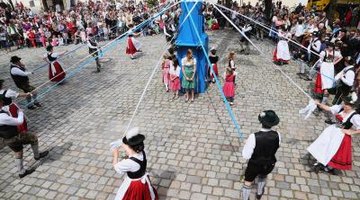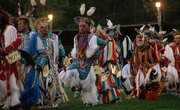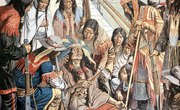The 1st of May heralds May Day in many European countries. Germans usually celebrate May Day with traditional costumes and dances, local food, beer brewed especially for the holiday and a maypole. The maypole is a spring symbol that dates back to pagan times. Today, May Day and the maypole in Germany carry special traditions.
History
May Day traditions are believed to stem from the ancient pagan festival of Beltane. Ancient Germanic people believed that each tree contained a soul, and they planted trees to commemorate births. They celebrated the marriage of the earth goddess by decorating a tree with ribbons and flowers, similar to modern decorations. They also planted a young birch on May 1st as a dedication to the pagan gods. Young men expressed their adoration for young ladies by decorating birch branches and placing them either on her roof or outside her window. These traditions related to pagan fertility rites.
Raising the Maypole
Raising the maypole symbolizes the planting of trees and spring's reawakening. Preparations for May Day festivities begin weeks in advance. Because neighboring towns compete to create the most attractive maypole, "experts" carefully select and fell a tall, beautiful tree. Artisans paint and decorate the maypole, complete with craftsmen's crests, a wreath and long ribbons for the dance. Traditionally, the men of the town raise the maypole on April 30, a sometimes difficult job because they can be as tall as 90 feet. The men use a system of hoists made of smaller, stripped-bare trees to heave the pole into place.
Stealing the Maypole
One May Day tradition in Germany is the climbing of the maypole. Men show off their prowess by climbing a tall, polished tree without benefit of handholds. When they're not climbing them, they're apparently stealing them. Because the maypole is a sign of a town's "fertility," rival towns typically try to steal other towns' maypoles. In fact, towns have started guarding their maypoles from the time the tree is felled until the end of May Day festivities. Thefts do occur, and towns have had to give over "copious" amounts of beer and food as ransom to retrieve their maypoles.
Maypole Dance
The cherished tradition of the maypole dance is another symbol of spring's reawakening. The tradition starts with dancers holding the end of one of the ribbons fastened to the wreath high up the pole. They keep the ribbon stretched. Traditionally, men face one way and women another. The dancers move in the direction they're facing, alternately clockwise and counterclockwise, passing the ribbon over shoulders so that the central dancers have to duck. As they do so, the ribbons become braided; the dance ends when the dancers are coupled up.
Related Articles
References
Writer Bio
Nadia Archuleta has a B.A. in English writing. She spent five years working abroad and has traveled extensively. She has worked as an English as a Foreign/Second Language teacher for 12 years.










